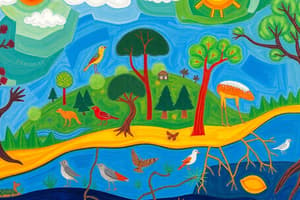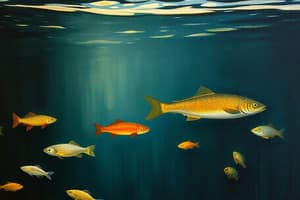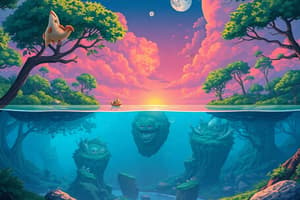Podcast
Questions and Answers
Which of the following is an example of a primary consumer?
Which of the following is an example of a primary consumer?
- Rabbit (correct)
- Shark
- Fox
- Eagle
Detritivores are organisms that only feed on living plants.
Detritivores are organisms that only feed on living plants.
False (B)
What is the role of decomposers in an ecosystem?
What is the role of decomposers in an ecosystem?
Decomposers break down dead organic matter and extract remaining energy.
The second level in a food chain is occupied by ______.
The second level in a food chain is occupied by ______.
Match the following terms with their correct definitions:
Match the following terms with their correct definitions:
What is the primary source of energy for ecosystems?
What is the primary source of energy for ecosystems?
Energy from the Sun is only necessary during certain seasons for ecosystems to function properly.
Energy from the Sun is only necessary during certain seasons for ecosystems to function properly.
What process do green plants use to capture sunlight and convert it into chemical energy?
What process do green plants use to capture sunlight and convert it into chemical energy?
Energy in a food chain is passed from species to species when _____ eat plants.
Energy in a food chain is passed from species to species when _____ eat plants.
Match the following life processes to their descriptions:
Match the following life processes to their descriptions:
What is the term used for the ecological role and space that an organism fills in an ecosystem?
What is the term used for the ecological role and space that an organism fills in an ecosystem?
Herbivores are animals that eat only other animals.
Herbivores are animals that eat only other animals.
Name one abiotic factor in an ecosystem.
Name one abiotic factor in an ecosystem.
Plants and algae are known as __________ because they trap the energy in sunlight and produce their own food.
Plants and algae are known as __________ because they trap the energy in sunlight and produce their own food.
Match the type of consumer with their feeding behavior:
Match the type of consumer with their feeding behavior:
What percentage of energy is typically passed from one trophic level to the next?
What percentage of energy is typically passed from one trophic level to the next?
The Pyramid of Biomass shows an increase in total mass of organisms as one progresses towards the top of the food chain.
The Pyramid of Biomass shows an increase in total mass of organisms as one progresses towards the top of the food chain.
What is the primary purpose of ecological pyramids?
What is the primary purpose of ecological pyramids?
The grass captures ______ kJ of energy from the sun in the energy flow example.
The grass captures ______ kJ of energy from the sun in the energy flow example.
Match the following ecological pyramids with their descriptions:
Match the following ecological pyramids with their descriptions:
What trend is observed in the Pyramid of Numbers as you move up the food chain?
What trend is observed in the Pyramid of Numbers as you move up the food chain?
The Pyramid of Biomass shows that the total biomass increases from producers to top consumers.
The Pyramid of Biomass shows that the total biomass increases from producers to top consumers.
What is the main difference between the Pyramid of Numbers and the Pyramid of Biomass?
What is the main difference between the Pyramid of Numbers and the Pyramid of Biomass?
The total biomass of producers is generally greater than the total biomass of __________.
The total biomass of producers is generally greater than the total biomass of __________.
Match the following examples with their corresponding categories in the ecosystem:
Match the following examples with their corresponding categories in the ecosystem:
What process do producers use to convert carbon dioxide into glucose?
What process do producers use to convert carbon dioxide into glucose?
The carbon cycle operates independently from other biogeochemical cycles.
The carbon cycle operates independently from other biogeochemical cycles.
Name one type of carbon compound that glucose is converted into by plants.
Name one type of carbon compound that glucose is converted into by plants.
During photosynthesis, plants take in ________ from the atmosphere.
During photosynthesis, plants take in ________ from the atmosphere.
Match the following terms with their definitions:
Match the following terms with their definitions:
What is the primary source of carbon for water plants in aquatic ecosystems?
What is the primary source of carbon for water plants in aquatic ecosystems?
Deforestation decreases the amount of carbon dioxide in the atmosphere.
Deforestation decreases the amount of carbon dioxide in the atmosphere.
What are two natural sources that can disrupt the carbon cycle?
What are two natural sources that can disrupt the carbon cycle?
Burning fossil fuels releases carbon dioxide into the Earth's __________.
Burning fossil fuels releases carbon dioxide into the Earth's __________.
Match the following carbon pools with their characteristics:
Match the following carbon pools with their characteristics:
Which process involves organisms converting carbon compounds into energy?
Which process involves organisms converting carbon compounds into energy?
Which of the following processes is primarily responsible for converting nitrogen gas into ammonia?
Which of the following processes is primarily responsible for converting nitrogen gas into ammonia?
Only producers carry out cellular respiration.
Only producers carry out cellular respiration.
What is released back into the atmosphere by decomposers?
What is released back into the atmosphere by decomposers?
Plants and phytoplankton solely produce oxygen through photosynthesis without any assistance from bacteria.
Plants and phytoplankton solely produce oxygen through photosynthesis without any assistance from bacteria.
During photosynthesis, plants convert ______ and water into glucose and oxygen.
During photosynthesis, plants convert ______ and water into glucose and oxygen.
What is the chemical formula for oxygen gas?
What is the chemical formula for oxygen gas?
The process of converting nitrogen gas into ammonia is called __________.
The process of converting nitrogen gas into ammonia is called __________.
Match the following stages of the carbon cycle with their descriptions:
Match the following stages of the carbon cycle with their descriptions:
Match the following processes with their descriptions:
Match the following processes with their descriptions:
Which of the following human activities contributes to an increase in carbon dioxide in the atmosphere?
Which of the following human activities contributes to an increase in carbon dioxide in the atmosphere?
Combustion of fossil fuels decreases the amount of carbon dioxide in the atmosphere.
Combustion of fossil fuels decreases the amount of carbon dioxide in the atmosphere.
What is the primary natural source of carbon dioxide release associated with volcanic activity?
What is the primary natural source of carbon dioxide release associated with volcanic activity?
Deforestation reduces the amount of plants available for __________.
Deforestation reduces the amount of plants available for __________.
Match the following carbon cycle disturbances with their descriptions:
Match the following carbon cycle disturbances with their descriptions:
Flashcards
Ecology
Ecology
The study of how living things interact with each other and their environment.
Ecologist
Ecologist
A scientist who studies ecology.
Ecosystem
Ecosystem
A community of living things (biotic) interacting with their non-living environment (abiotic).
Niche
Niche
Signup and view all the flashcards
Producers
Producers
Signup and view all the flashcards
Primary Consumers
Primary Consumers
Signup and view all the flashcards
Secondary Consumers
Secondary Consumers
Signup and view all the flashcards
Tertiary Consumers
Tertiary Consumers
Signup and view all the flashcards
Decomposers
Decomposers
Signup and view all the flashcards
What is photosynthesis?
What is photosynthesis?
Signup and view all the flashcards
What is a food chain?
What is a food chain?
Signup and view all the flashcards
What is energy flow in an ecosystem?
What is energy flow in an ecosystem?
Signup and view all the flashcards
Why is there less energy available at higher trophic levels?
Why is there less energy available at higher trophic levels?
Signup and view all the flashcards
What happens to the energy that is not used by organisms?
What happens to the energy that is not used by organisms?
Signup and view all the flashcards
Pyramid of Energy Flow
Pyramid of Energy Flow
Signup and view all the flashcards
Pyramid of Numbers
Pyramid of Numbers
Signup and view all the flashcards
Pyramid of Biomass
Pyramid of Biomass
Signup and view all the flashcards
10% Energy Transfer Rule
10% Energy Transfer Rule
Signup and view all the flashcards
Trend in Pyramid of Numbers
Trend in Pyramid of Numbers
Signup and view all the flashcards
Trend in Pyramid of Biomass
Trend in Pyramid of Biomass
Signup and view all the flashcards
Key Takeaway - Energy Flow
Key Takeaway - Energy Flow
Signup and view all the flashcards
What is the Carbon cycle?
What is the Carbon cycle?
Signup and view all the flashcards
How do producers participate in the carbon cycle?
How do producers participate in the carbon cycle?
Signup and view all the flashcards
How does carbon return to the environment?
How does carbon return to the environment?
Signup and view all the flashcards
What is the significance of biogeochemical cycles?
What is the significance of biogeochemical cycles?
Signup and view all the flashcards
Photosynthesis
Photosynthesis
Signup and view all the flashcards
Cellular Respiration
Cellular Respiration
Signup and view all the flashcards
The Carbon Cycle
The Carbon Cycle
Signup and view all the flashcards
Carbon Sequestration
Carbon Sequestration
Signup and view all the flashcards
What is nitrogen fixation?
What is nitrogen fixation?
Signup and view all the flashcards
How do fossil fuels affect the carbon cycle?
How do fossil fuels affect the carbon cycle?
Signup and view all the flashcards
What do nitrogen-fixing bacteria do?
What do nitrogen-fixing bacteria do?
Signup and view all the flashcards
How does deforestation affect the carbon cycle?
How does deforestation affect the carbon cycle?
Signup and view all the flashcards
What are nitrifying bacteria?
What are nitrifying bacteria?
Signup and view all the flashcards
How do plants use nitrogen?
How do plants use nitrogen?
Signup and view all the flashcards
What natural sources impact the carbon cycle?
What natural sources impact the carbon cycle?
Signup and view all the flashcards
Why is the nitrogen cycle important?
Why is the nitrogen cycle important?
Signup and view all the flashcards
How does the ocean play a role in the carbon cycle?
How does the ocean play a role in the carbon cycle?
Signup and view all the flashcards
Combustion's role in carbon cycle
Combustion's role in carbon cycle
Signup and view all the flashcards
Volcanic activity's role in carbon cycle
Volcanic activity's role in carbon cycle
Signup and view all the flashcards
Deforestation impact on carbon cycle
Deforestation impact on carbon cycle
Signup and view all the flashcards
Fossil fuels' impact on carbon cycle
Fossil fuels' impact on carbon cycle
Signup and view all the flashcards
Human impact on carbon cycle
Human impact on carbon cycle
Signup and view all the flashcards




